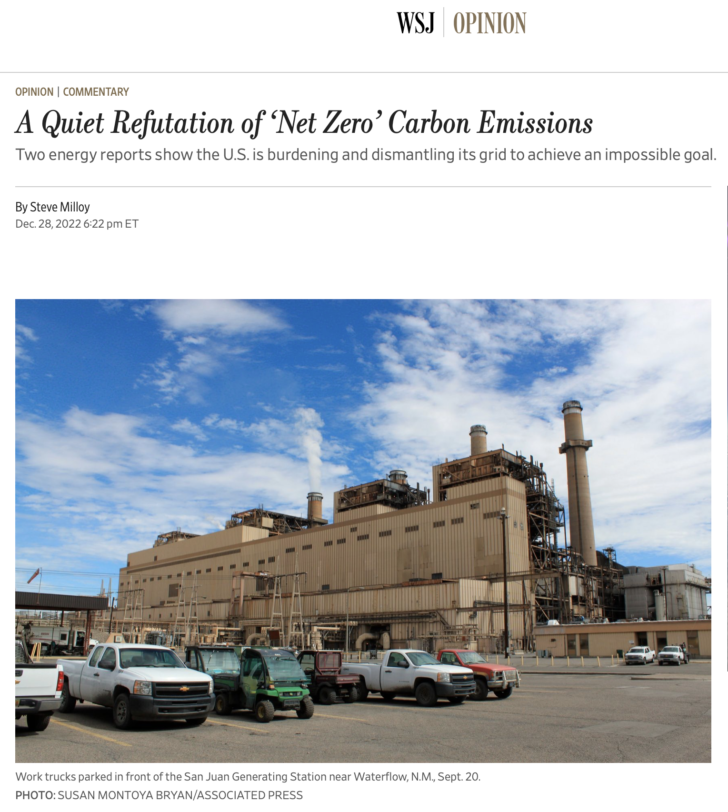My latest in the Wall Street Journal (Web | PDF).

‘Net zero by 2050” is more than a slogan of climate activism. It has become a chief organizational principle for multinational corporations and the BlackRock-led cartel pushing environmental, social and corporate governance investing.
“Net zero” was mentioned in more than 6,000 filings with the Securities and Exchange Commission in 2022 and countless other times by publicly traded corporations and investor groups in statements and on their websites. The SEC says its proposed climate disclosure rule will help investors “evaluate the progress in meeting net-zero commitments and assessing any associated risks.”
“Net zero” and its corollary, the “energy transition,” are talked about so often and so loosely that many take them for granted as worthy goals that could be accomplished with greater buy-in from political and business leaders. But two new reports from the utility industry should put an end to such loose talk.
In September, the Electric Power Research Institute, the research arm of the U.S. electric utility industry, released a report titled “Net-Zero 2050: U.S. Economy-Wide Deep Decarbonization Scenario Analysis.”
The EPRI report concludes that the utility industry can’t attain net zero. “This study shows that clean electricity plus direct electrification and efficiency . . . are not sufficient by themselves to achieve net-zero economy-wide emissions.”
In other words, no amount of wind turbines, solar panels, hydropower, nuclear power, battery power, electrification of fossil-fuel technologies or energy-efficiency technologies will get us to net zero by 2050.
Even to achieve “deep decarbonization”—which isn’t net zero—by 2050, EPRI says, “a broad portfolio of options that includes low-carbon fuels and carbon removal technologies will be required.”
But “low-carbon fuels”—efficient biofuels—don’t exist. “Carbon removal technologies” aren’t possible to scale up, and if they were, it would cost about $1 quadrillion—a million billion dollars—at today’s prices to remove the 1.6 trillion tons of atmospheric carbon dioxide that U.S. climate envoy John Kerry said needs to be sucked “out of the atmosphere even after we get to net zero.”
There’s more. The EPRI report states: “This study does not include a detailed assessment of factors such as supply chain constraints [and] operational reliability and resiliency” of a net-zero electricity grid.
How a net-zero grid could be built and function would be an issue worth studying if it were possible in the first place. But it simply isn’t.
So, barring some unforeseen miracle technology, “net zero by 2050” won’t happen.
The curious thing about the report is that it has largely remained an EPRI secret. There has been no media coverage of it. I found out about it only after I filed a shareholder proposal about net zero with the electric utility Alliant Energy. The company offered the report as a defense against my proposal that management explain how it planned to reach its goal of net zero by 2050.
The other recent report is “2022 Long-Term Reliability Assessment” from the North American Electric Reliability Corp., a government-certified grid-reliability and standard-setting group. NERC concluded that fossil-fuel plants are being removed from the grid too fast to meet continuing electricity demand, and that is putting most of the country at risk of grid failure and blackouts during extreme weather. The U.S. just got another taste of this during the Christmas electric-grid emergency.
So there you have it: We are dangerously dismantling our electric grid while burdening it with more demand in hope of attaining the goal of “net zero by 2050,” which the utility industry has admitted is a fantasy.
Congress should hold hearings on “net zero by 2050” goals before real disaster happens. It should bring in witnesses from utilities, public-service commissions, grid operators, regulators and the ESG cartel and have them explain under oath how they plan to accomplish the impossible.
Mr. Milloy is a senior fellow with the Energy and Environment Legal Institute.
Appeared in the December 29, 2022, print edition as “A Quiet Refutation Of ‘Net Zero’”.
there are two groups invested in this insanity. The first are the stupid people looking for salvation because they know they are inherently useless, so they chase after any and every crusade like ‘save the whales’ and now ‘stop global warming’, which is a fools errand. They will kill us all without hesitation if it feeds their feelings of being important.
The second group are the grifters and politicians (redundant, I know). They are after all the power and money they can take from us and don’t care if we freeze or starve. IMAO they are sociopaths. The scam is a perfect tool for them.
In this mix are the damnable corporate media spewing anything and everything that will cause panic, such as covid and AGW. “If it bleeds, it leads!”
“The whole aim of practical politics is to keep the populace alarmed (and hence clamorous to be led to safety) by an endless series of hobgoblins, most of them imaginary.” – H.L. Menken
Thanks for the article Steve. I know it has been pointed out before, but in New Mexico, the decimation of fossil fuel power plants and Oil and Gas production has been used as a political cudgel also. In a state with a liberal Governor, and with a history of decades of a liberal legislature, the hardest hit areas of our “net-zero” push, economically, are the Northwest corner, and Southeast corners of the State, which are historically Conservative, and do not vote with the liberal ‘Rio Grande Corridor’ crowd of Sante Fe, Taos, Bernalillo, Albuquerque, etc.